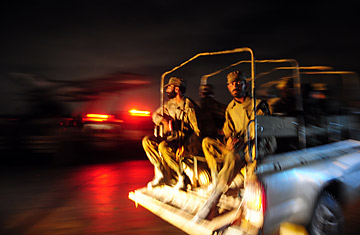
Pakistani soldiers enter a naval air base following an attack by militants in Karachi early on May 23
(2 of 2)
The military policeman is mystified as to how the attackers managed to pierce the facility's security perimeter. "There is a first checkpoint, then a second checkpoint, and even if those fail, there are watchtowers with snipers inside," he says. Interior Minister Malik said the attackers were as discreet as possible. Using ladders, they breached a vulnerable wall near the Malir tributary. They then used cutters, which were later found, to sever the barbed wire that curled across the top of the wall.
According to Malik's account, the attackers cleverly exploited a blind spot between two security cameras. They were dressed in black clothing too, he said, making it difficult for them to be spotted in the Karachi night. Once inside, they used rocket-propelled grenades to destroy two Lockheed Martin P-3C Orion aircraft.
The location is significant. Nearby is a monument consecrated to the memory of the more than 130 people who were killed when two suicide bombers attacked the convoy of former Prime Minister Benazir Bhutto on her return to Pakistan in October 2007.
The aircraft struck by the attackers were given to Pakistan in June 2010 by the U.S. They were modified to help with counterterrorism activities. The enhanced planes were used to carry out surveillance missions to assess whether approaching boats were carrying material that could be used by terrorists. As part of the U.S.-led naval Combined Task Force 150, the Pakistani navy helps prevent the movement of extremists from Somalia and Yemen, as well as protect ships arriving with NATO supplies.
The focus on the hangar housing the Orions aroused suspicions of inside collusion. "The people who attacked knew what time would be most appropriate. They knew from where to enter and how to go about it," says retired Air Marshal Riazuddin Shaikh. "It seems they had a lot of information. The question is whether it was provided to them. It is my feeling that it was." To support his suspicions, Shaikh cites the discovery that assassination attempts on former military ruler General Pervez Musharraf were traced to inside the military. The lower ranks, he says, need to be carefully vetted and purged of elements with fundamentalist sympathies.
Malik declined to discuss the possibility of complicity from within the military but said President Asif Ali Zardari had ordered an inquiry. As for the authorship of the attack, the Pakistani Taliban have already claimed responsibility. After Osama bin Laden's death, Malik said, al-Qaeda elements and the Pakistani Taliban convened somewhere in Waziristan to plot a series of revenge attacks. "They decided to attack the army, security installations and some VIPs," he said. The naval-base siege is the third in what many fear will become a ferocious wave of terrorist attacks following bin Laden's slaying.
While the Interior Minister urged his compatriots to unite against terrorists in their midst, Malik was almost amusingly evasive about the identities of the slain attackers. They had sharp features, fair skin and tiny beards and were in their early 20s, he said. They looked "like the Star Wars characters," Malik said.
"I'm just glad he's blaming the aliens and not us," Omar Abdullah, the Chief Minister of Indian-administered Kashmir, joked on Twitter. "That's a huge improvement in our relations."
Perhaps. But judging by the reactions of Pakistanis to their latest ordeal, there are still dangerous divisions, with many still preferring to look beyond their borders in search of an elusive enemy instead of confronting those that lurk within.
